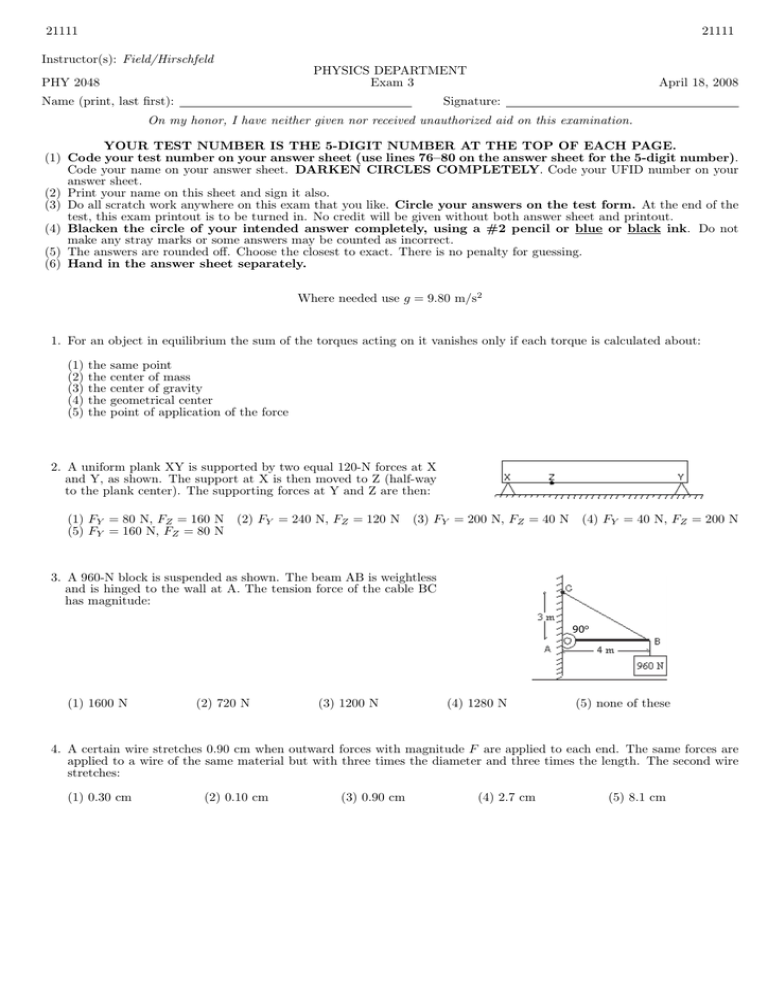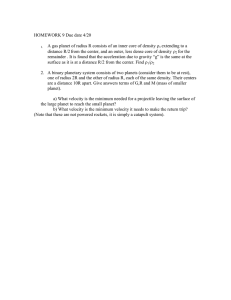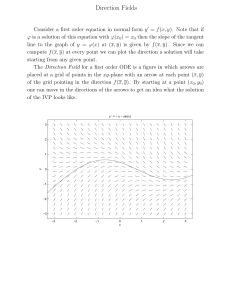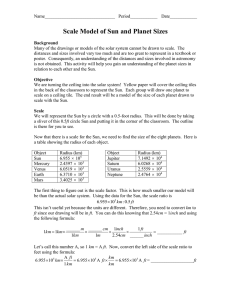21111 Field/Hirschfeld PHYSICS DEPARTMENT PHY 2048
advertisement

21111 21111 Instructor(s): Field/Hirschfeld PHY 2048 PHYSICS DEPARTMENT Exam 3 Name (print, last first): April 18, 2008 Signature: On my honor, I have neither given nor received unauthorized aid on this examination. YOUR TEST NUMBER IS THE 5-DIGIT NUMBER AT THE TOP OF EACH PAGE. (1) Code your test number on your answer sheet (use lines 76–80 on the answer sheet for the 5-digit number). Code your name on your answer sheet. DARKEN CIRCLES COMPLETELY. Code your UFID number on your answer sheet. (2) Print your name on this sheet and sign it also. (3) Do all scratch work anywhere on this exam that you like. Circle your answers on the test form. At the end of the test, this exam printout is to be turned in. No credit will be given without both answer sheet and printout. (4) Blacken the circle of your intended answer completely, using a #2 pencil or blue or black ink. Do not make any stray marks or some answers may be counted as incorrect. (5) The answers are rounded off. Choose the closest to exact. There is no penalty for guessing. (6) Hand in the answer sheet separately. Where needed use g = 9.80 m/s2 1. For an object in equilibrium the sum of the torques acting on it vanishes only if each torque is calculated about: (1) (2) (3) (4) (5) the the the the the same point center of mass center of gravity geometrical center point of application of the force 2. A uniform plank XY is supported by two equal 120-N forces at X and Y, as shown. The support at X is then moved to Z (half-way to the plank center). The supporting forces at Y and Z are then: (1) FY = 80 N, FZ = 160 N (2) FY = 240 N, FZ = 120 N (3) FY = 200 N, FZ = 40 N (4) FY = 40 N, FZ = 200 N (5) FY = 160 N, FZ = 80 N 3. A 960-N block is suspended as shown. The beam AB is weightless and is hinged to the wall at A. The tension force of the cable BC has magnitude: 90o (1) 1600 N (2) 720 N (3) 1200 N (4) 1280 N (5) none of these 4. A certain wire stretches 0.90 cm when outward forces with magnitude F are applied to each end. The same forces are applied to a wire of the same material but with three times the diameter and three times the length. The second wire stretches: (1) 0.30 cm (2) 0.10 cm (3) 0.90 cm (4) 2.7 cm (5) 8.1 cm 21111 21111 5. The magnitude of the acceleration of a planet in circular orbit around the Sun is proportional to: (1) (2) (3) (4) (5) the the the the the mass of the Sun mass of the planet distance between the planet and the Sun reciprocal of the distance between the planet and the Sun product of the mass of the planet and the mass of the Sun 6. Each of the four corners of a square with edge a is occupied by a point mass m. There is a fifth mass, also m, at the center of the square. To remove the mass from the center to a point far away, the work that must be done by an external agent is given by: √ √ (1) 4 2Gm2 /a (2) −4Gm2 /a (3) 4Gm2 /a (4) −4 2Gm2 /a (5) 4Gm2 /a2 7. An object is dropped from an altitude of one Earth radius above Earth’s surface. If M is the mass of Earth and R is its radius, the speed of the object just before it hits Earth is given by: p p p p p (1) GM/R (2) GM/2R (3) 2GM/R (4) GM/R2 (5) GM/2R2 8. The approximate value of g at an altitude above Earth equal to one Earth radius is: (1) 2.5 m/s2 (2) 9.8 m/s2 (3) 4.9 m/s2 (4) 1.9 m/s2 (5) 1.1 m/s2 9. An airtight box, having a lid of area 80 cm2 , is partially evacuated. Atmospheric pressure is 1.01 × 105 Pa. A force of 600 N is required to pull the lid off the box. The pressure in the box was: (1) 2.60 × 104 Pa (2) 6.35 × 104 Pa (3) 7.50 × 104 Pa (4) 1.38 × 105 Pa (5) 1.76 × 105 Pa 10. A bucket resting on the floor of an elevator contains an incompressible fluid of density ρ. When the elevator has an upward acceleration a, the pressure difference between two points in the fluid separated by a vertical distance ∆h, is given by: (1) ρ(g + a)∆h (2) ρa∆h (3) ρg∆h (4) ρ(g − a)∆h (5) ρga∆h 11. A wood board floats in fresh water with 60% of its volume under water. The density of the wood in g/cm3 is: (1) 0.6 (2) 0.4 (3) 0.5 (4) more than 0.6 (5) less than 0.4 12. One end of a cylindrical pipe has a radius of 1.5 cm. Water (density = 1.0 × 103 kg/m3 ) streams steadily out at 7.0 m/s. The rate at which mass is leaving the pipe is: (1) 4.9 kg/s (2) 2.5 kg/s (3) 7.0 kg/s (4) 12 kg/s (5) 48 kg/s 13. A particle moves back and forth along the x axis from x = −xm to x = +xm , in simple harmonic motion with period T . At time t = 0 it is at x = +xm . When t = 0.75T : (1) (2) (3) (4) (5) it it it it it is is is is is at x = 0 and is traveling toward x = +xm at x = 0 and is traveling toward x = −xm at x = +xm and is at rest between x = 0 and x = +xm and is traveling toward x = −xm between x = 0 and x = −xm and is traveling toward x = −xm 21111 21111 14. A block attached to a spring oscillates in simple harmonic motion along the x axis. The limits of its motion are x = 10 cm and x = 50 cm and it goes from one of these extremes to the other in 0.25 s. Its amplitude and frequency are: (1) 20 cm, 2 Hz (2) 40 cm, 2 Hz (3) 20 cm, 4 Hz (4) 40 cm, 4 Hz (5) 25 cm, 4 Hz 15. It is impossible for two particles, each executing simple harmonic motion, to remain in phase with each other if they have different: (1) periods (2) masses (3) amplitudes (4) spring constants (5) kinetic energies 16. A certain spring elongates 9 mm when it is suspended vertically and a block of mass M is hung on it. The angular frequency of this mass-spring system is: (1) is 33 rad/s (2) is 0.088 rad/s (3) is 200 rad/s (4) 1140 rad/s (5) cannot be computed unless the value of M is given 17. A 0.25-kg block oscillates on the end of the spring with a spring constant of 200 N/m. If the system has an energy of 6.0 J, then the amplitude of the oscillation is: (1) 0.24 m (2) 0.06 m (3) 0.17 m (4) 4.9 m (5) 6.9 m 18. The displacement of a string is given by y(x, t) = ym sin(kx + ωt). The wavelength of the wave is: (1) 2π/k (2) 2πk/ω (3) k/ω (4) ωk (5) ω/k 19. Water waves in the sea are observed to have a wavelength of 300 m and an angular frequency of 0.44 Hz. The speed of these waves is: (1) 21 m/s (2) 0.21 m/s (3) 0.021 m/s (4) 2.1 m/s (5) none of these 20. Sinusoidal waves travel on five identical strings. Four of the strings have the same tension, but the fifth has a different tension. Use the mathematical forms of the waves, given below, to identify the string with the different tension. In the expressions given below x and y are in centimeters and t is in seconds. (1) (2) (3) (4) (5) y(x, t) = y(x, t) = y(x, t) = y(x, t) = y(x, t) = (2 (2 (2 (2 (2 cm) cm) cm) cm) cm) sin sin sin sin sin (4.1x − 10.2t) (2.7x − 5.4t) (3.8x − 7.6t) (5.9x − 11.8t) (0.8x − 1.6t)






